Editor’s Note.
My friend, Joseph Thomas, is an intense human being. When he feels strongly about something, he is a man possessed. Last year, when Srinagar valley was inundated by the Jhelum waters, he said that this disaster was unnecessary. Having been posted in J&K in 1962-64, having flown over the valley and done aerial survey, he knows the terrain better than most people. Due to siltation and the construction of embankments, the river is flowing at a level higher than most parts of the city. Continuing siltation makes the situation worse and the river is bound to overflow the embankments. In 2014, it took a long time for the flood waters to recede, because of the high level of the river bed. Thomas suggested that the river be de-silted and dredged to prevent recurrence of this calamity. He wrote a detailed paper with specific recommendations, and embellished it with pictures and diagrams. It was posted on this blog on Sep 20, 2014. Please click on the following link to see it:
http://amolak.in/web/flood-prevention-in-the-vale-of-kashmir-by-joseph-thomas/
The paper was very well received and its gist was also published elsewhere. However, Thomas did not stop at this. He reached out to the powers that be through all means. In Urdu, they call it a ‘Junoon.’ I told him several times that flood waters were most unlikely to reach his flat in Bengaluru (especially since he lives on an upper floor) but that did not make much difference. Then I told him that his three children and the grand children, being tucked away at a safe distance in the USA, were also not threatened by this menace. But for Thomas, every one living in the Kashmir valley is as dear to him, as his own kith and kin.
It gives me great pleasure to inform you that his voice has been heard. The J & K government has floated a tender for dredgers, and once the process is set in motion, action will ensue. Whether his name figures in the list of the ‘Padma’ awards next year is of no consequence. The satisfaction of an end achieved is a reward by itself. A sequel to the above paper is placed below. Your comments are solicited.
*
SEQUEL TO FLOOD CONTROL IN THE VALE OF KASHMIR
By Wg Cdr Joseph Thomas, VM (Veteran)
Executive Summary
Srinagar sits in an alluvial basin and is well known as a flood prone area. The problem has been compounded by the construction of embankments on either side of the Jhelum river. Progressive silting of the river has raised the river bed till it is higher than street level.
The stretch of the river from Sopore to Baramulla has the same features but has been regularly dredged and de-silted. However, for some inexplicable reason, no de-silting has been done from Srinagar to Wular lake.
Severe floods occurred in the Kashmir valley in September 2014. The embankments gave way at several locations and most of the river emptied out into the city. Diverting some of the water to the flood channel merely resulted in flooding rural areas also.
A far more elegant solution to river flooding is to de-silt the river, thereby increasing its carrying capacity. Sand mining also has the same effect — at no cost to the government — and needs to be encouraged. Our blog came out with a detailed explanation of all this in September 2014 itself. However, we were surprised at the sheer apathy of the government and the general public. A sustained campaign was, therefore, undertaken in the electronic media and by interacting with opinion makers.
We are glad to report that the J & K government has seen reason and has now issued a tender for purchase of two cutter suction dredgers. This is a case study on the importance of public opinion in a democracy.
*
The gestation period for a human baby is nine months. It has taken the same gestation period for our recommendation on flood prevention in the Vale of Kashmir.
When our article was published in September 2014, all the talk was about digging a new flood channel for the Jhelum. J&K Chief Minister Omar Abdullah wrote to Prime Minister Narendra Modi in Sep 2014 seeking an in-depth study on whether an alternative channel for the Jhelum could be created to carry extra water during a flood. Accordingly, an “expert team” was asked to assess the reasons for the flooding, and whether an alternative channel circling the town is technically and financially feasible. The proposal to divert the Jhelum is not new. It has been talked about in the state as a permanent solution to the flooding and water-logging that is regularly witnessed during the rainy season. It was estimated that Rs 8,500 crore would be required to create this channel. [The actual cost would more likely be of the order of Rs 1,00,000 crores.]
A damaged house boat in Srinagar
Till March 2014, the Centre and the state government were discussing a Rs 2,000 crore plan to strengthen the embankments of the Jhelum, which gave in during heavy rainfall at the start of September. Most parts of Srinagar are lower than the river-bed of the Jhelum. As an immediate step, however, Rs 100 crore was given to the state government to do emergency repair on the embankments, but it turned out to be a case of too little, too late. – See more at: http://indianexpress.com/article/india/india-others/the-flood-effect-centre-asks-if-jhelum-can-be-made-to-skirt-srinagar-2/#sthash.5GL82HAt.dpuf
When an embankment gets breached, the entire river empties into the city
When an embankment gets breached, the entire river empties into the city
Diverting the river around Srinagar is feasible but at prohibitive cost. Firstly, a lot of land is required. Secondly, a large number of bridges will have to be built across the new river channel. Thirdly, when the new river channel gets silted up, embankments will be built on either side. Eventually, the river will again flow above street level. We will be back to square one.
What is inexplicable is that the stretch between Sopore and Khadanyar (just downstream of Baramulla) has been regularly dredged from 1959 onwards. This stretch has, therefore, escaped floods, even in the great flood of 2014. Yet, the authorities were loath to learn a lesson and persisted with their grandiose scheme of a second flood channel.
Similarly, sand mining has been permitted in the Sindh river, a tributary of the Jhelum. As a result the carrying capacity of the river was maintained and no floods occurred in 2014. Yet, sand mining is regularly vilified and discouraged, if not prohibited.
The Jhelum river in good times
We found that merely publishing an article in this blog was not enough. We embarked on a sustained campaign through social media and the press. Every time an article appeared in the media we wrote comments and drew attention to our blog. We were fortunate in getting an early supporter — Er Ashraf Fazili, retired Chief Engineer, PWD, J & K. He gave an interview to “Greater Kashmir” newspaper in October 2014 stating that floods can be prevented if the bed level of Jhelum is brought below the street level. See http://www.greaterkashmir.com/news/2014/Oct/13/-floods-can-be-prevented-if-the-bed-level-of-jhelum-is-brought-below-the-street-level–7.asp#sthash.tl5KTYAO.dpuf
Er Ashraf Fazili has followed it up at meetings of engineers and officials. See also his blog https://shahishaharyar.wordpress.com/2014/10/14/2014-centuries-worst-flood-in-kashmir
Sept 2014 flood in Srinagar
It has helped that “Greater Kashmir” newspaper has a Facebook page. We “liked” it, thereby getting a daily feed. Every time an article appeared on flood control in the Valley, we wrote comments both on the paper’s website and in Facebook. Convincing the editors of the paper was another major step forward. The paper came out with two editorials urging the government to de-silt the Jhelum river.
Since the Central government is involved and no progress was apparent on that front we registered on the Prime Minister’s website and posted this message : “Last year’s flood in Srinagar was catastrophic because the Jhelum river has bunds on both sides that make it flow above street level. When the river level rises above the bund, the entire river empties into the city. Far simpler, better and less expensive to dredge and de-silt the river. The alternative proposal to construct a second flood channel will be less effective and will cost at least Rs one lakh crores extra.” Even though the PM’s site claims “interaction with the Prime Minister” there has been no response from the PMO. However, we presume that our post was forwarded to the Central Water Commission.
Dr Shibu Mani, professor from Centre for Disaster Management, Tata Institute of Social Sciences, Mumbai noticed our blog and wrote “It was a very interesting post indeed. I have begun a work (at a pilot level) to categorize floods in Himalayan region (latitudinal window). The primary objective is to have interaction with those who have experience on floods in the Himalayan region (engineers, river dynamics scientists, academicians and so on to get a multi discipline nature). I could find who posted in this forum including the author of the post are potential resource persons. Those who are willing to share their experiences, would you please send a mail to my email ID so that I can contact.”
We did contact Prof Shibu Mani and he took the trouble of visiting Bangalore. We spent an interesting morning discussing various aspects of flood control. It turned out that our perspective is quite different from various “experts” in flood control. He promised to put across our ideas to his students and to guide them on research projects into floods in Kashmir, Bihar and elsewhere. He also forwarded some articles on flood control in the Kosi river basin in Bihar.
The Kosi river floods are far worse than in Kashmir, mainly because it covers a much larger area. There also the flood control authorities have relied on embankments. We commented on the articles and that put us in touch with Er Dinesh Mishra an activist in Agra who has written a full book on the subject. He remarked “You are the first person who says let us discuss.”
The next opinion maker we came in contact with is Abdul Rashid Khan, retired IGP of J&K Police. We responded to an article he wrote in Greater Kashmir. In a democracy, public opinion is very important and that is why Political Science trumps all other Science disciplines. It was, therefore, a major milestone to find a retired IGP writing in “Greater Kashmir” on 10 Apr 15 :
“The September floods have left an indelible impact on our minds and in March we just escaped the fury somehow. ………..The September floods have already rendered the city into shambles and the recent rains are posing more threat to very existence of the city. The traders of the Lal Chowk during their recent interaction with the CM, were right in making the submission that the future need is to have the permanent remedial measures. Therefore the few suggestions can be thought over.
a Immediate dredging and de-silting of river Jhelum, Doodh Ganga, Flood spill channels of Rambagh, Rawlpora and strengthening of their embankments.
b ……………………..
[Full article at http://www.greaterkashmir.com/news/2015/Apr/10/save-srinagar-3.asp]
Retd IGP Abdul Rashid Khan while putting forth eight recommendations, the first of which is to de-silt the Jhelum river, its tributaries and the existing flood channel, did not even mention the grandiose idea of constructing a second flood channel.
This was a welcome development and we became cautiously optimistic that the flood problem in the Kashmir Valley would be solved.
Sadaf Masoodi, Dr Javid Iqbal, Arif Shafi Wani, M Ashraf and Tasaduq Hussain also wrote articles in “Greater Kashmir” but did not respond to our comments.
File Photo regularly used by “Greater Kashmir” when publishing an article on floods in Kashmir.
This shows the flood channel taking off from a bend in the river.
On 04 Apr 15 “Greater Kashmir” newspaper carried a report that the Central Govt will take a decision on flood control measures on 07 Apr 15. Rs 401 cr were expected to be sanctioned for ”dredging of river Jhelum and land acquisition to widen the river’s flood channel.”
There is really no need to widen the flood channel. We need a certain cross sectional area to accommodate the expected water flow. This can be achieved by deepening the flood channel. There is no need for additional land. The money can be better spent for deepening the flood channel.
Though we should make one caveat. The current flood channel does not extend all the way to Wular Lake. It ends in a rural area. What it basically does is to divert the flood from the city to the rural areas. In case the land acquisition is for extending the flood channel upto Wular Lake, then it is a good idea and long overdue.
The Seminar Held in November 2014
A two day national seminar on “Retrospective and Prospective of 2014 Kashmir Floods for Building Flood Resilient Kashmir” was held at Srinagar from 15-16 November 2014. The seminar was organised jointly by the Department of Earth Sciences, Kashmir University and Centre for Dialogue and Reconciliation (CDR), a Delhi based NGO. The project was jointly supported by the European Union and Friedrich Naumann Stiftung FUR DIE FREIHEIT
Their report was published in April 2015 but came to public notice only when Er Ashraf Fazili wrote about it. The material had already come in the media but in bits and pieces. We now had a comprehensive account and now we knew the source. Extracts from the report (in maroon) and our comments :
Sand Mining
“There were suggestions made towards banning the illegal extraction which was changing the water regime of the rivers causing maximum slope failure in Sumbal Sonawari area.”
Sand mining at the river banks will cause the banks to collapse. However, sand mining in the middle of the river helps to de-silt the river, thereby increasing its carrying capacity. Sand mining can cause a local depression in the river bed but that does not cause a problem to the flow. Sand mining needs to be encouraged. The authorities seem to be doing the opposite.
Reducing the Velocity of Water Flow !
“There were various methods discussed which could reduce the velocity of water too.”
Reducing the velocity of water flow will actually cause increased flooding. It is incredible that such a statement was made by “experts.”
The Vaunted Alternative Flood Channel
“From the total project cost of Rs. 2200 crores, about Rs. 1800 crores is required for only compensation.”
The alternative flood channel is no solution. It is merely a grandiose plan.
The estimate is highly unrealistic. The actual cost is more likely to be in the region of Rs 1,00,000 crores
Dredging
“Resurrecting and dredging are two important recommendations that need to be continued for flood mitigation and control. A suggestion was made to make the efforts time bound and finish the process by March-April, 2015.”
The elegant solution.
April 2015 has come and gone. But better late than never.
Hiring an International Consultant
“The State Government must hire an international consultant for planning the Srinagar city. The City plan should be drafted holistically, by taking on board experts from diverse scientific fields. India is now shifting its cities to Smart City Concept and J&K should also follow.”
We produce over one lakh engineers every year and a commensurate number of architects and town planners. We should all hang our heads in shame if our huge army of engineers, architects and town planners cannot do this job.
LIGHT AT THE END OF THE TUNNEL
M Ashraf writing in “Greater Kashmir” of 18 Jun 15 said “As regards dredging of the River, desilting of the flood spill over channel, strengthening of the embankments, and setting up of dewatering stations above the flood level no news is coming out. Even the drains and dewatering system appears to be without any major change. Apart from the city getting water-logged repeatedly, there are still some areas in the valley water logged from the previous flood.”
However, a June 17th article in “Greater Kashmir” by Arif Shafi Wani is more encouraging. He reported that Chief Engineer, Irrigation and Flood Control, Javid Jaffar said that in last nine months, the department had been working to strengthen the flood defence mechanism. “We have been undertaking dredging at problematic spots. However, we can start dredging on large scale when Government of India will release funds for it. The Rs 400 crore project for Jhelum conservation has been recently approved and sent to Finance Ministry for sanction. We hope that the funds will be released at the earliest. We have also floated tenders for procuring two dredgers,” the CE added.
http://www.greaterkashmir.com/news/srinagar-city/flood-mismanagement-worry-srinagar/189597.html
This is great news and the first confirmation that the efforts by all of us is starting to produce results.
Old and new dredgers in operation near Baramulla
In the foreground – a Dragon dredger that has been in operation for nearly 60 years. Working behind it is a new Series 370 dredger.
Video of this dredger being towed and positioned can be seen below:
A CURE WORSE THAN THE DISEASE
Here the cure is worse than the disease. Soil is being taken from the river bank near Baramulla and dumped into the Jhelum river. This reduces the carrying capacity of the river and can cause flooding. Also, the silt will go downstream and damage the turbines of the Uri hydroelectric plant.
A cutter suction dredger operating near Baramulla
The June 17th article in “Greater Kashmir” by Arif Shafi Wani sent us searching for the J&K govt tender and we found it at https://jktenders.gov.in/nicgep/app
Extracts from the tender :
Irrigation and Flood Control Dept
Tender Reference Number MCOIandFC01of2015
Tender Id 2015_IFC_17967_1
Tender Type Global Tender
Tender Fee (INR) 20,000
EMD Amount (INR) 24,00,000
Title
DESIGN SUPPLY AND COMMISSIONING OF CUTTER SUCTION DREDGES
Work Description
Selection, Design, Manufacture, Packaging, Forwarding, Assembling, Installation, Testing, Commissioning and Trial Running of Cutter Suction Dredges having propulsion system capable of meeting the requirements and parameters as given in document.
Estimated value INR 12,00,00,000
Period Of Work(Days) 120
Bid Validity(Days) 180
Pre Bid Meeting Date
15-Jun-2015 11:00 AM
Published Date
29-May-2015 01:30 PM
Bid Opening Date
07-Jul-2015 11:00 AM
Document Download / Sale Start Date
30-May-2015 10:00 AM
Document Download / Sale End Date
04-Jul-2015 04:00 PM
Bid Submission End Date
04-Jul-2015 04:00 PM
A cutter suction dredger manufactured in India. This one has tracks and crawls on the river/lake bed.
CUTTER SUCTION DREDGERS
A cutter suction dredger is a stationary or self-propelled vessel that uses a rotating cutter head to loosen the material in the bed (‘cutting’).
A suction inlet located beneath the cutter head (known as the suction mouth) is connected by a suction tube directly to one or more centrifugal pumps. The vacuum force at the suction inlet sucks up the loosened material. The suction tube and cutter head are attached to a ladder. The ladder with cutter head is positioned at the fore of the vessel.
The business end of a cutter suction dredger
The cutter suction dredger discharges the dredged material directly to shore via a floating pipeline or into a barge with a special loading system.
 A large cutter suction dredger
A large cutter suction dredger
For video on how a cutter suction dredger operates see
http://www.vanoord.com/activities/cutter-suction-dredger
http://www.jandenul.com/en/equipment/fleet/cutter-suction-dredger
So two dredgers are in the pipeline for Srinagar. The flood control department is also using excavators to operate in the tributaries and the flood channel. In view of the massive amount of dredging required, two dredgers are hardly enough. Still, a start has been made. The baby is born.
ACKNOWLEDGEMENT
Thanks are due to Er Ashraf Fazili for his sustained effort to convince the authorities to take up de-silting and dredging of the Jhelum river in the vicinity of Srinagar. Thanks to “Greater Kashmir” for publishing articles on the subject and for two editorials. Thanks to various authors mentioned who have written articles urging action. Above all, thanks to Gen Surjit Singh for overcoming my natural inertia and making me write.

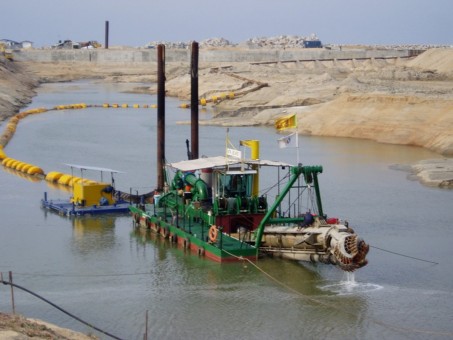
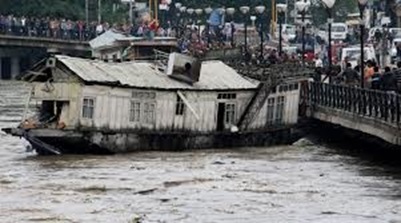


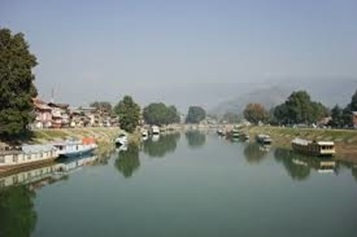
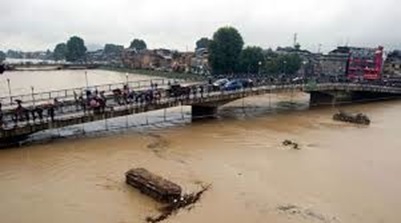
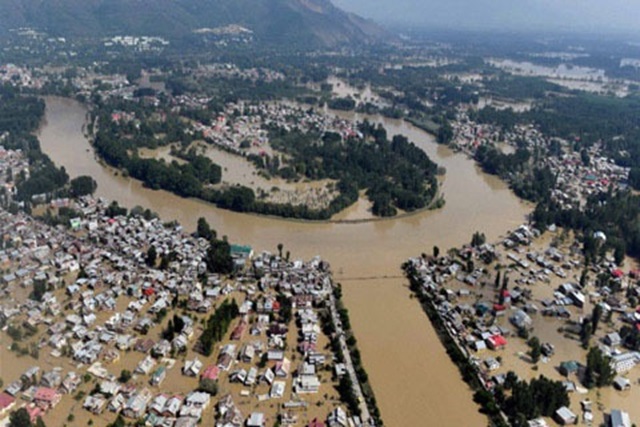
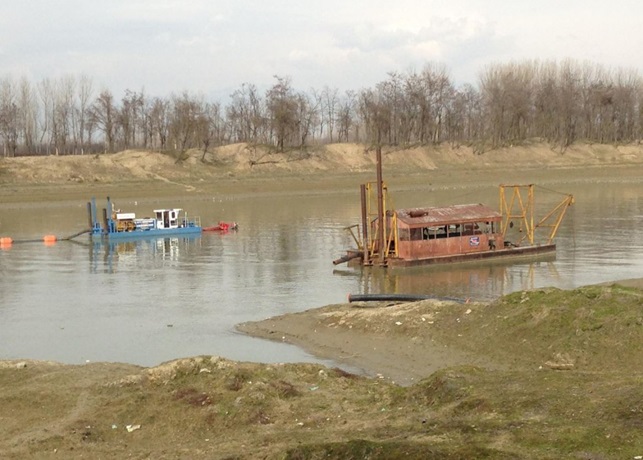








[...] http://amolak.in/web/sequel-to-flood-control-in-the-vale-of-kashmir-by-joseph-thomas/ [...]
Dear Mr Thomas,
I am Kashmiri civil engineer currently working in Delhi. Both your articles are very interesting reading – one of Sep 14 and the Sequel. We need to get something done about the floods in Kashmir. You must have heard that now the situation is such that with a couple of days of rainfall the gauge at Ram Munshi Bagh crosses the danger level.
However, while dredging is important i do not think it is ‘the’ solution. We need to work on an intergrated plan which will cover all possible options. God willing will write an article on this and share my views.
I understand you are based out of Bangalore. I do visit there quite often – at least once every month. it would be good to meet you in person at your convienience to discuss this further.
Regards
Iftikhar
Thanks Iftikar. We need to look at the basics of fluid flow. We have to deal with a certain amount of water flowing through the Jhelum during floods. The speed is entirely determined by the gradient. So that gives a certain cross sectional area. If that cross sectional area is available within the river banks, it is fine. If not, we get floods.
I have described how embankments create problems. The Jhelum river bed is above street level. Even if there is no overflow, there is water seepage underground. So the water table is at or above street level.
The flood channel is workable if it takes the flood water to the sea. The current flood channel merely diverts the flood from the city to the rural area. The poor rural folk have no voice.
Agreed that upstream flood control measures like dams and afforestation are feasible and desirable. I am not objecting to any logical flood control measure.
A new flood channel will (1) divert the flood from the city to the rural area. It is unfair.
(2) consume a lot of land. Again unfair to the rural folk.
(3) cost about Rs one lakh crores.
(4) de-silting the river and the existing flood channel is sufficient. Therefore, a second flood channel is unnecessary.
The minimum de-silting that should be done is to lower the river level to street level.
Yes, I am in Bangalore and will be glad to meet you. Please let me know your email ID and phone nr and I’ll get in touch.
I admire the passion of Wg commander J Thomas for taking up the cause of flood ravaged Kashmir and other places prone to similar catastrophe. I am not an expert on flood control measures but common sense says that river channels , particularly in the Himalayan region, would require dredging / de-silting periodically as rivers in spate carry down tremendous amount of silt and boulders. Sand mining of the river beds has unpleasant connotation and loud protests are raised over the issue particularly when it comes to sand mining of Ganga in Haridwar. It can also be effective if sand mining is done in the middle of the river bed but not the banks. Contractors will surely do a better job than a government department , due to latter’s proven apathy to social causes which do not give monetary return. However, there is a caveat that contractors must be supervised and monitored so that they do not lift sand from the river banks which is an easier option and hence more profitable. Kudos to enterprising men , whether in armed forces or civilians. whether serving or retired,who put the Nation and people first.
Thanks Mahavir for the kind comments which do encourage me.
Entirely agree with you regarding sand mining. It is extremely useful in flood control.
You may be interested in our latest article “THE CHENNAI FLOODS OF 2015 – HISTORY REPEATS ITSELF” which is also posted in this website.
Happy New Year !
[...] Joseph Thomas on SEQUEL TO ‘FLOOD CONTROL IN THE VALE OF KASHMIR’ by Joseph Thomas [...]
Mohammad Ashraf, I.A.S. (Retired), is a Former Director General Tourism, Jammu & Kashmir. This is indeed encouraging. It means that opinion makers are urging the government to take urgent action.
Dredge The Jhelum, Please!
By M.Ashraf
24 December, 2015
http://www.countercurrents.org/ashraf241215.htm
Dear Sirs,
While I read your article shared by Mr. Ashraf Fazili with interest, I would appreciate to get your email address as being from Kashmir & actively involved in the Dredging & marine industry for over 2 decades globally based in Middle East ,it would be wise to share ideas.
I can also be reached via mobile : +971503435337 or skype:munirmufti.
I think your article does not touch on the dredger / equipment specifications required for such projects. I note with interest the Lousy Ellicot which has a refutable history being privileged by J&K Government for unknown reasons.
Regards
Munir
Dear sir, thanks for your interest. I am not from Kashmir, though I served there several decades ago. I am not a dredging expert and got into flood control as a matter of general interest. Hydrodynamics and subsonic aerodynamics are very similar. In fact, the latter is derived from Hydrodynamics.
Glad that you are actively involved in the dredging and marine industry. You may like to promote your business with the J&K Government. I have no connection with them, or any other govt.
Yes, my article does not touch on the dredger/equipment specifications. The picture of the Ellicot dredger was included in the article because it is already in use. Other pictures are for illustration only.
Best wishes.
Dear JT Sir,
You hit the nail on the head long ago. It is sad that we skip the obvious escape route and take the contorted ones to confound ourselves. Here’s hoping that wisdom prevails at least now.
Best regards,
M V Kannan
well Done, Tommy and Surjit!
Bosch
I read with great interest JT’s article on dredging the Jhelum. I fully agree with his views having been in the Valley for over 10 years in different postings as an engineer. Having been involved in the widening and strengthening of the Jammu – Srinagar Highway between Ramban and Srinagar from 1967 to 1972 we went though some of the old reports on the river beds when we had to construct bridges. We found that the bed levels had risen in a matter of 10 years since the report had been given by the Border Roads. This was due to heavy silting. It is therefore not surprising that the Jhelum is heavily silted. The problem is not restricted to the Jhelum alone as the city has a number of major storm and sullage water drains/canals. These too would have silted hugely. Dredging these would be also very important.
I used to shoot ducks and fish in the Wular lake in the seventies. I found at many places that the bed of the Wular was hardly 3 feet, even quite away from the banks. No doubt sedimentation does take place in different areas based on the flow of the water. The fact is that the lake too has never been desilted. When it fills up the restricted flow through the dam near Mahura does not clear adequately clear the flood waters thus creating a back flow. So it is very important that Wular too needs to be dredged.
Sadly having interacted with civil authorities, the PWD and a few agencies (all corrupt to the core) I really wonder if they have the wherewithal to do the job effectively on a war footing within the allocated budget.
Till then despite a alienated poulation the Army and Air Force will do a thankless job of Aid to Civil Power!
Jai Hind!!!
Thanks Vivek for your comments.
Two dredgers have been in use in the stretch of the river from Sopore to Baramulla.
Result — no floods in 2014
Sand mining has been permitted in the Sindh river.
Result — no floods in 2014.
Embankments have been built on either side of the river in Srinagar.
Result — catastrophic floods in 2014.
At least now, the conversation has changed. Even the TV anchors are talking of de-silting and dredging. The minister for irrigation and flood control has talked of outsourcing the dredging. The machinery is moving.
Thank you Sir.
regards,
Hari Kumar
Dear Surjit,
Thanks a lot! Nice to know that a few right views too are appreciated at least by some one some time?
Thank you all to continue persiung the views you considered to be right, forgetting whether they are implmented or otherwise!
Regards.
MNKelkar
XIX NDA 2956-Old C (New Echo)
Hope the authorities take the task seriously and on priority with time bound programme.
Dear Joseph
Gratifying news indeed.
But I’m guessing you’ll be also keeping an eye on just how well the dredging is executed…?
Paul
WELL DONE TOMMY
MORE POWER TO YOUR ELBOW !!!!!!!!!!!
Great post!
Thanks for sending it to me.
Thanks for sharing and hearty congratulations, Joe on your sustained efforts to make a difference.
I am so glad the efforts you made to suggest a sound solution to the problem of flooding in the vale of Kashmir has /is bearing fruit.
Best regards,
Prem
A single ripple is all that is required to shake up the surface of a calm lake. A single champion for the poor can shake up the inertia of indifference,especially by using the social media and mass communication.” Messages will fly, in the twinkling of an eye”. ..so predicted a wise lady in the 17 th century.
So keep up the good work each and every one ,for the poor folks whose very existence is threatened due to indifference.
Well done,Wing Commander Joseph Thomas…may the ripple you started ,and all the folks who have taken up the cause ,bring relief and prosperity to the residents along the river of beautiful Srinagar..
Keep it up,……champion other causes too.
Retired folks Do have the Time and KNOWLEDGE and so can move mountains !Perhaps folks in employment are fearful of losing their jobs,and so keep a low profile..
Continue the good work everyone. Congratulations .
You are not fused bulbs or spent cartridges
What a fantastic but simple solution! This dredging should be done continuously so that the Jhelum is tamed and does not overflow its banks or break through the embankments. Our congratulations to Wg Cdr Joseph and a hope that his idea is followed to the hilt by the Government of Jammu and Kashmir.
I must Joe for his inputs at all levels. I wish I had a passion for a cause like him.
Well done Joe.
Best Dave Sood
Best Regards,
Dave Sood
Managing Director
AIE
D-57 Chattarpur Enclave,
New Delhi, India 110074
+91 98100 37663
Sir,
That is good news. Indeed the river bed was the problem.
Yawar Baig
Sir,
If I am not wrong, the Britishers had an insight on this and had way back made some recommendations which if implemented could have averted the disaster.
We are what we are, and we get what we deserve!
Kulbir
Sir, the British were consulted in 1902 and I have written about it in the first article. They dredged with a steam dredger in the stretch downstream of Wular lake i.e. from Sopore to Khadanyar. Then they constructed a flood channel which takes off from Padshahi Bagh in Srinagar and is 42 km long. This flood channel ends in the countryside. What it does is to divert approx 1/3 of the water from Srinagar to the rural areas. This was standard practice in British times — save the cities at the expense of the rural areas. They also built embankments on both sides of the Jhelum at Srinagar. Continued siltation reduces the carrying capacity of the river and the flood channel. So the embankments are raised higher and higher till we get the weird situation where the river is higher than the city.
In September 2014 the govt also dynamited the embankment upstream of the city, thereby flooding the rural areas downstream. The clamour has been “Why did they not dynamite it earlier ?”
The govt has not formally given up the plan for a second flood channel. But, at least, they have started the process for dredging at Srinagar. They should also encourage sand mining.
Thanks.
The article shows what concerted efforts by dedicated persons can achieve in our democracy.
Regards,
Surendra
Sir,
Indeed, a true HERO in many ways; we need more of them ….
Sanjeev
In a social gathering last year, an elderly veteran remarked, “Ah, well, what difference does it make whether one was a Major or a General, after retirement we are fused bulbs. The wattage printed on our shells is of no consequence, since we emit no light!”
Another friend described us as ‘spent cartridges’. But every now and then I find a fused bulb or spent cartridge coming out with a brilliant idea. So we should pat the backs of the likes of Joseph Thomas, who has shown that we are capable of offering implementable solutions to complex problems.
“Lage Raho, Thomas Bhai” … “There are miles to go before you can sleep!”
Surjit
Thanks Surjit.
I’ve heard this ‘fused bulb’ remark earlier but ‘spent cartridge’ is new. Just a gentle hint that there is a subtle difference between those who leave early and those who superannuate. Of course, there are notable exceptions like you.